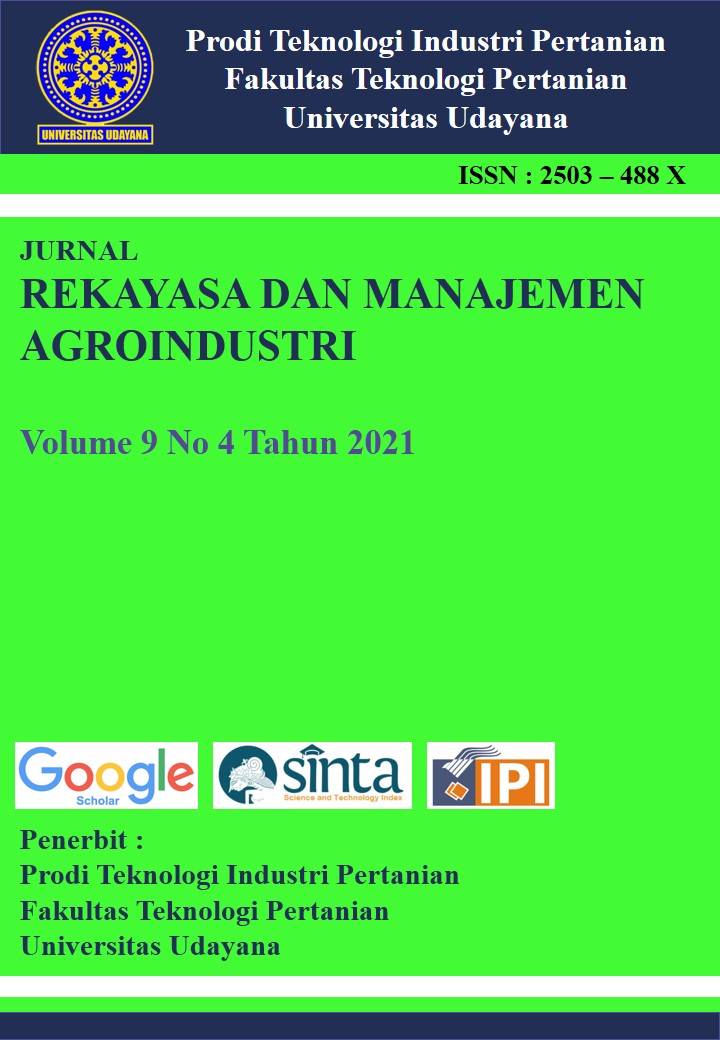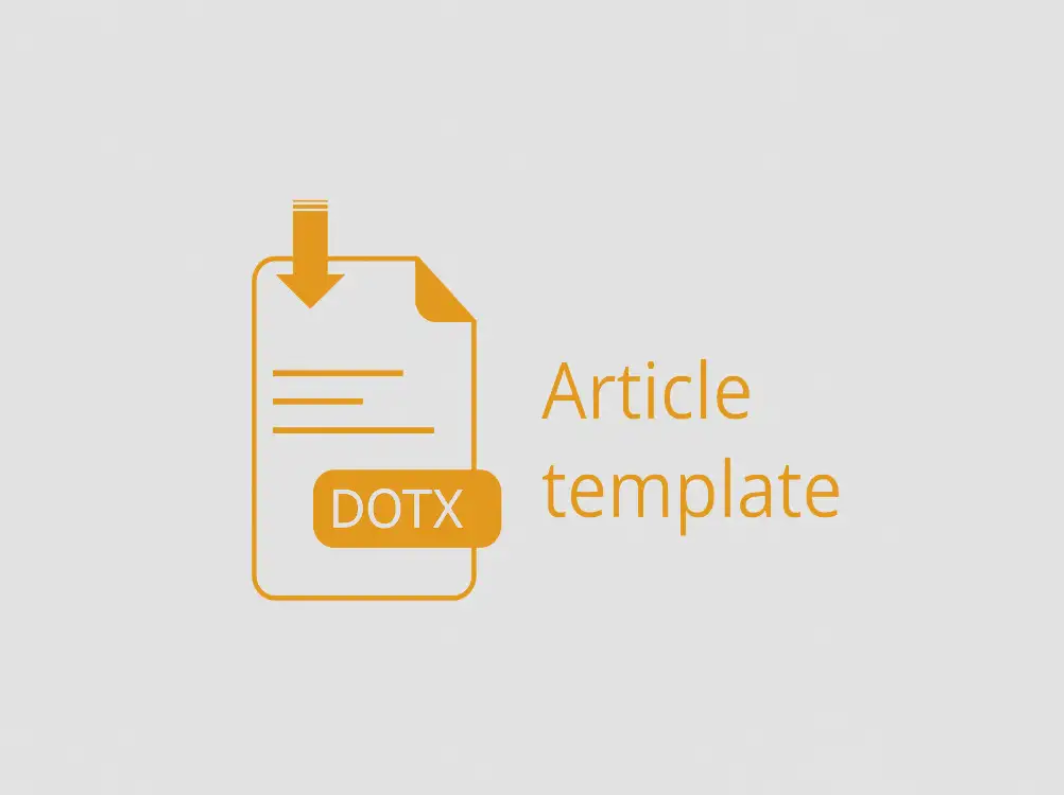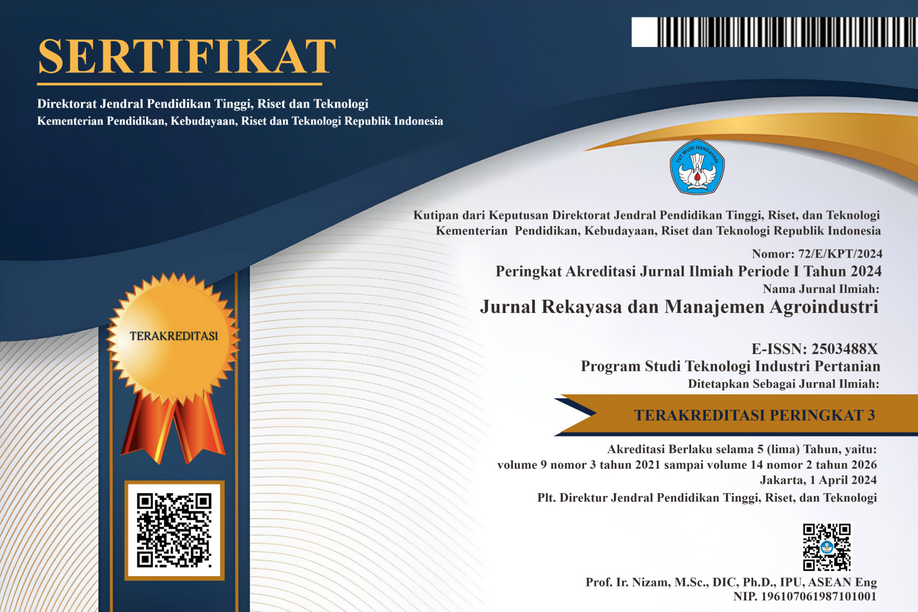Pengaruh Konsentrasi Penambahan Bubuk Kunyit (Curcuma domestica Val.) sebagai Pengampelas dan Antioksidan terhadap Karakteristik Krim Body Scrub
Abstract
This study aims to determine the effect of the concentration of turmeric powder (Curcuma domestica Val.) as an abrasive and an antioxidant on the characteristics of a body scrub cream and to determine the concentration of adding turmeric powder (Curcuma domestica Val.) as an abrasive and an antioxidant to produce the best characteristics of body scrub cream. This study used a randomized block design with variations in the concentration of turmeric powder with six concentration (0%, 2%, 4%, 6%, 8%, and 10%). The treatments were grouped into 3 based on the time of making body scrub cream so that 18 experimental units were obtained. Data were analyzed by analysis of variance and continued with Tukey's test. The concentration treatment of adding turmeric powder greatly affects pH, viscosity, spreadability, adhesion, total phenol, and overall organoleptic acceptance. The concentration of adding turmeric powder 4% is the best treatment to produce a body scrub cream with the following characteristics: pH 6.52, viscosity 26.933.33 cp, spreadability 5.15 cm, adhesion 9.71 seconds, total phenol 3.19 mgGAE /g, separator ratio= 1, and overall organoleptic acceptance of 6.40 (like to like very much).
Keywords : Body scrub cream, Curcuma domestica Val., Antioxidant, Sandpaper
Downloads
References
Ahadianti, K.M., L.P. Wrasiati., dan G.P. Ganda Putra. 2020. Pengaruh persentase penambahan bubuk serat oyong (Luffa acutangula) dan lama pengadukan terhadap karakteristik krim boaultondy scrub. Jurnal Rekayasa dan Manajemen Agroindustri. 8(3): 472-483. DOI: https://doi.org/10.24843/JRMA.2020.v08.i03.p15. Diakses pada tanggal 04 Agustus 2021.
Amallyah, B. 2013. Stabilitas fisika sediaan body scrub mengandung bekatul, Rice bran oil, virgin coconut oil (VCO), kopi ekstrak aloe vera. Skripsi S1. Tidak dipublikasikan. Fakultas Farmasi UBAYA, Surabaya.
Anief, M. 2008. Sistem dispersi, formulasi suspensi dan emulsi. Gadjah Mada University Press, Yogyakarta.
Anief, M. 2010. Ilmu meracik obat, teori dan praktik. Gadjah Mada University Press, Yogyakarta.
Betty, A. 2013. Stabilitas fisika sediaan body scrub mengandung bekatul, rice bran oil, virgin coconut oil (VCO), kopi dan ekstrak aloe vera dengan bahan pengawet dmdm hydantonin dan natrium benzoate. Jurnal Ilmiah UBAYA. 3(1):1-14.
Bintang, I. A. K., dan A.G. Nataatmaja. 2005. Pengaruh penambahan tepung kunyit (Curcuma domestica val) dalam ransum boiler. Prosding Nasional Teknologi Peternakan dan Veteriner, Bogor, p. 733-736.
Badan Standarisasi Nasional (BSN). 1996. SNI 16-4399-1996. Sediaan Tabir Surya. Badan Standardisasi Nasional, Jakarta.
Fitriani, R. A. 2015. Optimasi formula krim antibakteri ekstrak kulit buah manggis (Garcinia mangostana Linn) menggunakan asam stearat sebagai emulgator dan trietanolamin sebagai alkalizing agent dengan metode desain faktorial. Fakultas Farmasi. Universitas Muhammadiyah Surakarta.
Fukushima S, Yamaguchi M. (2001). Physical chemistry of cetyl alcohol: occurrence and function of liquid crystals in o/w creams. In: Matijevic E, editors. Surface and Colloid Science. New York: Springer Science Business Media. 16: 1-94.
Gitariastuti, N. K., S. Mulyani, L. P. Wrasiati. 2020. Pengaruh penambahan bubuk daun kelor (Moringa oleifera L.) dan suhu proses pemanasan terhadap karakteristik body scrub. Jurnal Rekayasa dan Manajemen Agroindustri, Universitas Udayana. 8(1):18-27. DOI:https://doi.org/10.24843/JRMA.2020.v08.i01.p03. Diakses pada tanggal 22 januari 2021.
Hanny, A. 2011. Beauty Spa di Rumah. Octopus, Jakarta.
Hardiyanthi, F. 2015. Pemanfaatan aktifitas antioksidan ekstrak daun kelor (Moringa oleifera) dalam sediaan hand and body cream. Skripsi S1. Tidak dipublikasikan. Fakultas Sains dan Teknologi UIN, Jakarta.
Herling dan L. Zastrow. 2001. Dangerous free radical in skin generated by UV-A irradiation. SOF W-Journal. 127: 24-32.
Hernani dan M. Rahardjo. 2005. Tanaman Berkhasiat Antioksidan. Penebar Swadaya, Jakarta.
Isfianti, D. E., dan O. K. Pritasari. 2018. Pemanfaatan limbah kulit buah jeruk nipis (Citrus aurantifolia) dan dau kelor (Moringa oleifera Lamk) untuk pembuatan lulur tradisional sebagai alternative “Green Cosmetics”. E-Journal, Universitas Negeri Surabaya. 7(2): 74-86
Lestari, U., F. Farid, dan P.M. Sari. 2017. Formulasi dan uji sifat fisik lulur body scrub arang aktif dari cangkang sawit (Elaeis Guineensis Jacg) sebagai detoksifikasi. Jurnal Sains dan Teknologi Farmasi. 19(1): 74-79.
Majeed, M., V. Badmaev., U. Shivakumar, and P. Rajendran. 1995. Curcuminoids: antioxidant phytonutrients. Nutri Science, New Jersey. p. 32-63
Mollet, H., A. Grubenmann. 2001. Formulation technology : emulsions, suspensions, solid form. Wiley-Vch. Toronto. p. 261-262.
Prabandani, R., dan H. Suherman. 2018. Formulasi uji stabilitas sediaan lulur dari rimpang kunyit (Curcuma longa linn). Viva Medika. p. 52-58.
Risha, N.A. 2016. Formulasi dan uji stabilitas fisik sediaan krim anti-inflamasi ekstrak etanol 70% herba kumis kucing (Orthosiphon stamineus Benth.). Fakultas Kedokteran dan Ilmu Kesehatan. Universitas Islam Negeri Syarif Hidayatullah, Jakarta.
Rohdiana, D. 2001. Aktivitas daya tangkap radikal polifenol dalam daun teh. Majalah Jurnal Indonesia. 12(1): 53-58.
Sakanaka, S., Y. Tachibana, and Y. Okada. 2003. Preparation and antioxidant properties of extract of japanese pearsimo leaf tea (Kakinocha-Cha). Journal Food Chemistry. 89: 569-57.
Setyaningsih, D., A. Apriyantono., dan M.P. Sari. 2010. Analisis sensori untuk indusri pangan dan agro. IPB Press, Bogor.
Shovyana, H.H., K. Zaulkarnain. 2013. Stabilitas fisik dan aktivitas krim w/o etanol buah mahkota dewa (Phaleria macrocarph (scheff) Beorl) sebagai tabir surya. Trad. Med. 18(2): 109-117.
Sihombing, P. A. 2007. Aplikasi ekstrak kunyit (curcuma domestica Val.) sebagai bahan pengawet mie basah. IPB Press, Bogor.
Smaoui, S., H.B. Hilma., R. Jarraya., N.G. Komoun., R. Ellouze. and M. Damak. 2012. Cosmetic emulsion of virgin coconut oil: formulation and biophysical evaluation. African Journal of Biotechnology. 11(34): 8417-8424.
Tranggono dan Latifah. 2007. Pengantar Kosmetologi. PT. Gramedia Pustaka Utama, Jakarta.
Voight, R. 1994. Buku Pelajaran Teknologi Farmasi. Gadjah Mada University Press, Yogyakarta.
Wahyuningtyas, S. E. P., M.G.D. Permana., A. Wiadnyani. 2017. Pengaruh jenis pelarut terhadap kandungan senyawa kurkumin dan aktivitas antioksidan ekstrak kunyit (curcuma domestica Val.). Jurnal ITEPA. 6(2): 61-70.

Ciptaan disebarluaskan di bawah Lisensi Creative Commons Atribusi-BerbagiSerupa 4.0 Internasional.
Seluruh artikel di Jurnal ini dapat disebarluaskan atas tetap mencantumkan sumber yang syah. Identitas judul artikel tidak boleh dihilangkan. Penerbit tidak bertangggung jawab terhadap naskah yang dipublikasikan. Isi artikel menjadi tanggung jawab Penulis.














